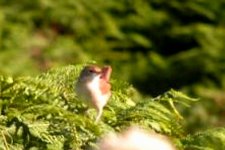Why is it not a Nightingale? Why is it a Whitethroat?
dan pointon said:Blinkin flip! 2 is 99.9% a Whitethroat, in that there's a tiny element of doubt that it could be something rarer, but it's not a Nightingale. 3 looks good for one as well. As for the Spot Fly, having had them in my garden all last summer i'd say posture wise alone this bird looks a pretty likely candidate to me!




